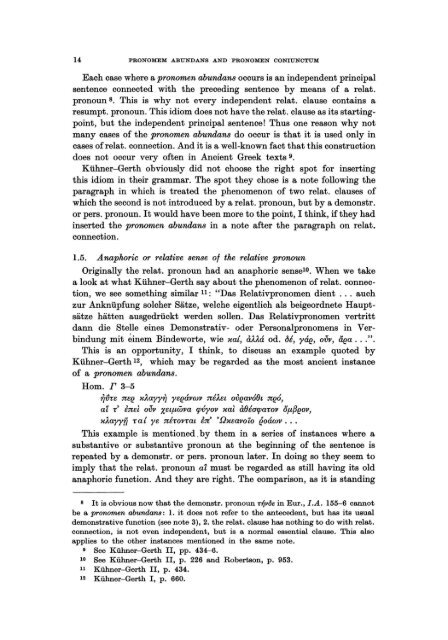Pronomen Abundans and Pronomen Coniunctum. A ... - DWC
Pronomen Abundans and Pronomen Coniunctum. A ... - DWC
Pronomen Abundans and Pronomen Coniunctum. A ... - DWC
Create successful ePaper yourself
Turn your PDF publications into a flip-book with our unique Google optimized e-Paper software.
14 PRONOMEM ABUNDANS AND PRONOMEN CONIUNCTUM<br />
Each case where a pronomen abundans occurs is an independent principal<br />
sentence connected with the preceding sentence by means of arelat.<br />
pronoun 8 . This is why not every independent relat. clause contains a<br />
resumpt. pronoun. This idiom does not have the relat. clause as its startingpoint,<br />
but the independent principal sentence! Thus one reason why not<br />
many cases of the pronomen abundans do occur is that it is used only in<br />
cases ofrelat. connection. And it is a well-known fact that this construction<br />
does not occur very of ten in Ancient Greek texts 9 .<br />
Kühner-Gerth obviously did not choose the right spot for inserting<br />
this idiom in their grammar. The spot they chose is a note following the<br />
paragraph in which is treated the phenomenon of two relat. clauses of<br />
which the second is not introduced by arelat. pronoun, but by a demonstr.<br />
or pers. pronoun. It would have been more to the point, I think, ifthey had<br />
inserted the pronomen abundans in a note af ter the paragraph on relat.<br />
connection.<br />
1.5. Anaphoric or relative sense ot the relative pronoun<br />
Originally the relat. pronoun had an anaphoric sense lO • When we take<br />
a look at what Kühner-Gerth say about the phenomenon of relat. connection,<br />
we see something similar 11: "Das Relativpronomen dient .. . auch<br />
zur Anknüpfung solcher Sätze, welche eigentlich als beigeordnete Hauptsätze<br />
hätten ausgedrückt werden sollen. Das Relativpronomen vertritt<br />
dann die Stelle eines Demonstrativ- oder Personalpronomens in Verbindung<br />
mit éinem Bindeworte, wie xat, à.V.á od. M, rele, oVV, äea . ..".<br />
This is an opportunity, I think, to discuss an example quoted by<br />
Kühner-Gerth 12, which may be regarded as the most ancient instance<br />
of a pronomen abundans .<br />
Hom. r 3-5<br />
~v-re nee x).arrT] reeávwv né)'u oveav6(h ne6,<br />
al 't" Ènet oVV XUI,Uvva !pVrov xal àOé(J(pa't'ov oplJeov,<br />
x).arrfi 't' a t re nÉ't'ov't'at Èn' 'Qxeavo io éoáwv . ..<br />
This example is mentioned . by them in a series of instances where a<br />
substantive or substantive pronoun at the beginning of the sentence is<br />
repeated by a demonstr. or pers. pronoun later. In doing so they seem to<br />
imply that the relat. pronoun al must be regarded as still having its old<br />
anaphoric function. And they are right. The comparison, as it is st<strong>and</strong>ing<br />
8 It is obvious now that the demonstr. pronoun T,p,«5e in Eur., I.A. 155-6 cannot<br />
be a pronomen abundans : 1. it does not refer to the antecedent, but has its usua1<br />
demonstrative function (see note 3), 2. the relat. c1ause has nothing to do with re1o.t.<br />
connection, is not even independent, but is a normal essentio.1 c1o.use. This o.1so<br />
o.pp1ies to the other instances mentioned in the same note.<br />
8 See Kühner-Gerth Il, pp. 434-6.<br />
10 See Kühner-Gerth Il, p. 226 o.nd Robertson, p. 953.<br />
11 Kühner-Gerth Il, p. 434.<br />
12 Kühner-Gerth I, p. 660.
















